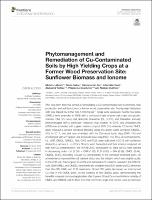Показать сокращенную информацию
Phytomanagement and Remediation of Cu-Contaminated Soils by High Yielding Crops at a Former Wood Preservation Site: Sunflower Biomass and Ionome
| dc.contributor.author | Mench, Michel J. | |
| dc.contributor.author | Dellise, Marie | |
| dc.contributor.author | Bes, Clémence M. | |
| dc.contributor.author | Marchand, Lilian | |
| dc.contributor.author | Kolbas, Aliaksandr | |
| dc.contributor.author | Le Coustumer, Philippe | |
| dc.contributor.author | Oustrière, Nadège | |
| dc.date.accessioned | 2020-09-16T12:13:11Z | |
| dc.date.available | 2020-09-16T12:13:11Z | |
| dc.date.issued | 2018-09-04 | |
| dc.identifier.citation | Mench, M.J. Phytomanagement and Remediation of Cu-Contaminated Soils by High Yielding Crops at a Former Wood Preservation Site: Sunflower Biomass and Ionome / M.J. Mench [et al.] // Frontiers in Environmental Science. – 2018. – Vol. 6, art. 123. – P. 1–17. | ru_RU |
| dc.identifier.issn | 2296-701X | |
| dc.identifier.uri | http://rep.brsu.by:80/handle/123456789/65 | |
| dc.description.abstract | This long-term field trial aimed at remediating a Cu-contaminated soil to promote crop production and soil functions at a former wood preservation site. Twenty-eight field plots with total topsoil Cu in the 198–1,169 mg kg−1 range were assessed. Twenty-four plots (OMDL) were amended in 2008 with a compost (made of pine bark chips and poultry manure, OM, 5% w/w) and dolomitic limestone (DL, 0.2%), and thereafter annually phytomanaged with a sunflower—tobacco crop rotation. In 2013, one untreated plot (UNT) was amended with a green waste compost (GW, 5%) whereas 12 former OMDL plots received a second compost dressing using this green waste compost (OM2DL, 5%). In 2011, one plot was amended with the Carmeuse basic slag (CAR, 1%) and another plot with a P-spiked Linz-Donawitz basic slag (PLD,1%). Thus six soil treatments, i.e., UNT, OMDL, OM2DL, GW, CAR, and PLD, were cultivated in 2016 with sunflower (Helianthus annuus L. cv Ethic). Shoots were harvested and their ionome analyzed. Athigh soil Cu contamination, the 1M NH4NO3-extractable vs. total soil Cu ratio ranked in decreasing order: Unt (2.35)>CAR (1.02), PLD (0.83)>GW (0.58), OMDL (0.44), OM2DL (0.37), indicating a lower Cu extractability in the compost-amended plots. Allamendments improved the soil nutrient status and the soil pH, which was slightly acidicin the UNT soil. Total organic C and N and extractable P contents peaked in the OM2DL soils. Both OMDL and OM2DL treatments led to higher shoot DW yields and Cu removals than the GW, CAR, and PLD treatments. Shoot DW yields decreased as total topsoil Cu rose in the OMDL plots, on the contrary to the OM2DL plots, demonstrating the benefits to repeat compost application after 5 years. Shoot Cu concentrations notably of OMDL and OM2DL plants fitted into their common range and can be used by biomass Mench et al. Phytomanagement of Cu-Contaminated Soils processing technologies and oilseeds as well. In overall, there is a net gain in soil physico-chemical properties and underlying soil functions. | ru_RU |
| dc.language.iso | en | ru_RU |
| dc.publisher | Frontiers Media | ru_RU |
| dc.relation.ispartofseries | Agroecology and Land Use Systems;Vol. 6 | |
| dc.subject | basic slag | ru_RU |
| dc.subject | compost | ru_RU |
| dc.subject | carbon sequestration | ru_RU |
| dc.subject | Helianthus annuus L. | ru_RU |
| dc.subject | marginal land | ru_RU |
| dc.subject | organic matter | ru_RU |
| dc.subject | phytoextraction | ru_RU |
| dc.subject | phytoremediation | ru_RU |
| dc.title | Phytomanagement and Remediation of Cu-Contaminated Soils by High Yielding Crops at a Former Wood Preservation Site: Sunflower Biomass and Ionome | ru_RU |
| dc.type | Article | ru_RU |
